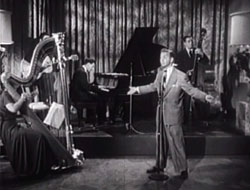 Blue Room (1950) opens with an electric guitarist playing a smooth jazz lick. Then out strolls a young Mel Torme with his hair trying to make him two inches taller. He sings:
Blue Room (1950) opens with an electric guitarist playing a smooth jazz lick. Then out strolls a young Mel Torme with his hair trying to make him two inches taller. He sings:
"From all visitors & inquisitors, we'll keep our apartment/ I won't change your plans, you arrange your plans, just the way your heart meant/ Here we'll see ourselves & we'll be ourselves, doing all the things we're scheming/ There are plans for us, something grand for us, where we two can be ourselves, dreaming."
The introduction for this Rodgers & Hart number was almost unbearable in tune & banality of lyrics. Then when the song proper begins, it's not a bad little slow-dance number, & the lyrics improve slightly: "We'll have a blue room/ A new room for two room/ Where day's a holiday/ Just because you're married to me..."
It's a romantic diddy, nothing thrilling. The song originated in the stage musical "The Girl Friend" (1926) & had been a chart hit for Perry Como a few years earlier. Perry sang it, while Cyc Charisse danced, in the musical film Words & Music (1948), wherein Mickey Rooney played Lorenze Hart. Mel also appeared in the film as himself, singing "Blue Moon" which is only coincidentally nearly homonymous with "Blue Room."
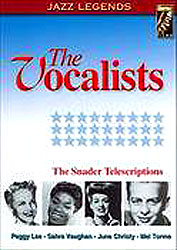 By right of the film, "Blue Room" was transiently a standard for jazz vocalists for a few years, but it really wasn't that good. Even Mel can't trick us into finding it timeless today, but he has charisma & a sweet voice. Too bad this couldn't've been his great hit "Blue Moon" instead of "Blue Room" though. By right of the film, "Blue Room" was transiently a standard for jazz vocalists for a few years, but it really wasn't that good. Even Mel can't trick us into finding it timeless today, but he has charisma & a sweet voice. Too bad this couldn't've been his great hit "Blue Moon" instead of "Blue Room" though.
The accompaniment is from a combo consisting of the guitarist, pianist, double bass player, & a harpist. And why are harpists, other than Harpo Marx, always women?
The stage setting is odd with draps imn the back, living room floor lamps at each side, a little raised area for three of the combo members. Looks rather like someone turned their apartment into a tiny club, with all the telescriptions sharing this set, having all been filmed in one day.
Three-minute telescriptions were originally filmed to be shown on early television as space-filler between longer programs, or serially like a radio disc jockey's program but needing the visuals. They were live performances unlike the soundies of the previous decade, which had the music recorded ahead of the visual content. Though soundies were sometimes bigger productions, the more simply filmed telescriptions have the added grace of being entirely the performance seen.
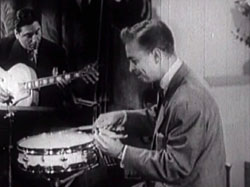 April Showers (1950) comes with a Studio Films title card, as do a couple others in the set. Studio was the company that took over the Snadar Telescription stock in 1953. But the setting is the same as for the 1950 Snaders, staged as the corner in a club that looks rather like a living room, with the combo that includes a harpist.
April Showers (1950) comes with a Studio Films title card, as do a couple others in the set. Studio was the company that took over the Snadar Telescription stock in 1953. But the setting is the same as for the 1950 Snaders, staged as the corner in a club that looks rather like a living room, with the combo that includes a harpist.
We first see the the bassist, then of the pianist & guitarist. These three guys are the Page Cavanaugh Trio (Cavanaugh on piano, Al Viola on guitar, Lloyd Pratt on bass), plus the harpist who might be June Weiland who recorded with Mel the year before (though he often had different harpists among his back-up groups, & it's not definitely known which woman this is).
Mel recorded many songs with the Page Cavanaugh Trio, but it might not be the same personel in the 1950 performances, I can't judge. The Trio made a few Snader telescriptiosn of their own around the same time as they did a few with Mel, besides backing up some other vocalists for Snader.
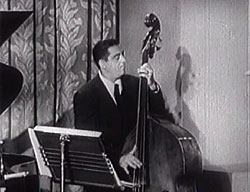 After we've seen the musicians, out strolls Mel to share the front of the staged setting, on the lower stage next to the harpist. He begins the hoary tune: After we've seen the musicians, out strolls Mel to share the front of the staged setting, on the lower stage next to the harpist. He begins the hoary tune:
"When April showers, they come your way/ They bring the flowers, that bloom in May/ So when it's raining, have no regrets/ Because it isn't raining rain it's raining violets..."
It's a great old classic but no one beats Al Jolsen. It's a tune from the beginning of the Roaring Twenties, though Jolsen's version wasn't recorded until 1932. It can be sung with such a jazzy tempo, as from Jolsen, but Mel has smoothed it out vocally without a strong beat while he's singing, preferring to be mainly melodious. At the instrumental break, however, the tempo jumps, & Mel joins the musicians with brushes on a snare drum.
Mel kept "April Showers" in his repertoir or decades so clearly loved the song. And anyone who strongly likes Mel "the Velvet Fog" will assuredly enjoy this & the other Snader live performances, though he's a mite too mellow to be totally exciting in these.
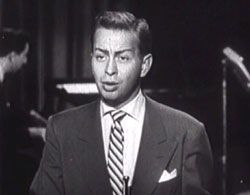 For You're Driving Me Crazy (1950) we're back on the same set seen in all Mel Tormet's Snader Telescriptions.
For You're Driving Me Crazy (1950) we're back on the same set seen in all Mel Tormet's Snader Telescriptions.
This one, too, has a 1953/4 Studio Films title card, but was filmed as part of the 1950 Snader set. Studio Films swapped out their own card when they bought out Snader.
The wrong date often given for these, 1951, may or may not be the release date when first aired on television. But the copyright on the original Snader title cards is 1950. Director Duke Goldstone was able to film as many as six telescriptions in a single day by sticking to one set, & the five that Mel shot would've taken up a full day of shooting.
This song had been with Mel practically his whole life. He first sang it at age four at the Blackhawk Club in Chicago where he grew up! He'd gone with his parents for one of their dinner outings & to hear the Coon-Sanders Orchestra.
As Mel recalled it, he was wearing a sailor suit & someone in the band said, "What a cute little boy!" Mel's motehr replied: "Yes, & he listens to your broadcasts religiously, knows every song. He sings right along with the radio."
They wanted to hear the wee sprite do just that, so he sang "You're Driving Me Crazy" so cutely that his parents brought him back every Monday night to do it again, earning $15 each time, & we can hope the meals were comped for the family.
The Walter Donaldson compositon was such a popular standard during the Roaring Twenties that even Betty Boop sang it. But for Mel's telescription performance, one of the camera angles has been changed to give at least a little variety to the setting that's reused in each of the films. We first see the Page Cavanaugh Trio from over the lady harpist's shoulders, guitar, piano, & double-bass arrayed from left to right.
With a jump-cut Mel appears center stage, raising his arms as he sings: "Ohhhhh you, you're driving me crazy/ What did I do, ohhh what did I do/ My tears for you, make everything hazy/ Clouding the skies of blue..."
It's a nice smoky-voiced romantic rendition of the standard. At an instrumental break there's a fine if rather short electric guitar solo, then right back to the vocal close.
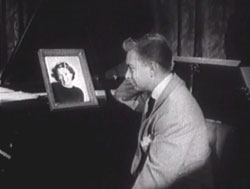 Mel's filmed-live performances of song standards for the three-minute telescriptions are mostly slow dance numbers that don't capture his hipper attributes.
Mel's filmed-live performances of song standards for the three-minute telescriptions are mostly slow dance numbers that don't capture his hipper attributes.
They're mainly songs he was exceedingly fond of, however, & would keep in his repertoir pretty much for his whole long career.
This time he selects something potentially uptempo, You Ought to be in Pictures (1950), but then sings it, as he did the other pieces, as a romantic ballad. It was written in 1934 by Dana Suesse & her lyricist Eddie Heyman.
It was first recorded by Paul Whiteman's orchestra, for whom Dana was a songwriter since 1932. She became known as "the girl Gershwin" & wrote many hits, none as big as this one however, which became so well known even Porky Pig stuttered through it in 1940.
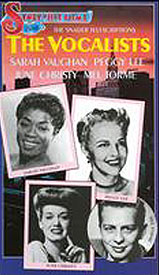 This is the only one of the telescriptions that attempts to include acting as was done in the earlier soundies of the 1940s. This is the only one of the telescriptions that attempts to include acting as was done in the earlier soundies of the 1940s.
It's the same stage filmed the same day as the others, but during the opening instrumental, Mel is shown mooning over a photograph of his presumed sweety, the photo set on the piano top.
The guitarist goes "Psst!" because Mel's so lost in feelings of love that he forgot to start singing. He looks momentarily caught in the headlights, then begins the lead-in lyrics:
"When I look at you, the thought goes through my mind/ What a marvelous find you'd make upon a screen/ Though I'm happy that I have you by my side/ I'd be satisfied to lend you to the public to be seen."
Then the song proper begins with a finer beat: "You otta be in pictures/ You're wonderful to see/ You otta be in pictures/ Oh whatta hit you would be..."
It's his nicest jazz interpretation among the telescriptions, even throwing in a "tooty fruity!" It's always a strange lyric for a guy to sing since it compares the singer's beloved to John Barrymore & Bing Crosby, which is a mite gay. For close Mel shuffle-dances back to his chair by the photograph.
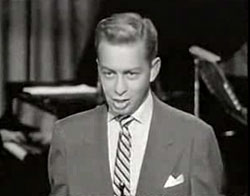 My personal favorite among the Snaders is Trouble Is A Girl (1950). Curiously, for a telescription, it pulls out the stops for fanciness.
My personal favorite among the Snaders is Trouble Is A Girl (1950). Curiously, for a telescription, it pulls out the stops for fanciness.
The opening lines of instrumentation is haunting & very slow, then Mel strolls out slowly, slowly as a transparent figure. A ghost is about to sing!
He materializes more fully as he begins with tragic visage, "Trouble is a girl/ A girl who loves me no more, no more/ Trouble is a girl/ A girl I'll always adore..."
This is superb bluesy torch song with Mel in top form sings it at the bottom of his register, proving himself all but unbeatable as an interpreter of emotive lyrics.
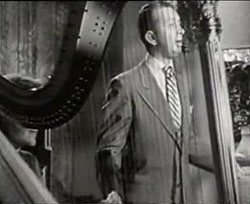 It sounds like the ideal theme song for a frightening film noir. The film could even have been titled Trouble is a Girl. It sounds like the ideal theme song for a frightening film noir. The film could even have been titled Trouble is a Girl.
The last shot has the camera filming Mel through the strings of the harp, pretty fancy cinematography compared to the other Snaders filmed that day.
Mel's telescriptions can be found on the compilation dvd The Snader Telescriptions: The Vocalists (1988) aka, Jazz Legends: The Vocalists (2004, together with Peggy Lee, Sarah Vaughn, & June Christy telescriptions); Swingtime Video: Meet the Singers Volume 2 (1985); aka, The Vocalists: Sarah Vaughan, Peggy Lee, June Christy, Mel Torme(1985).
Four of five of the telescriptions can be found on Swing Era: George Shearing (2003) along with clips & telescriptions featuring Slim Gaillard, Tony Pastor, Ralph Flanagan, The Bobcats, etc).
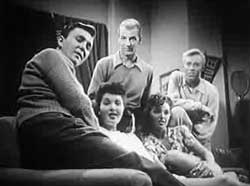 The Mel-Tones were the back-up vocalists for Mel Torme, but here in the visual jukebox soundie Lullaby of Broadway (1945) they're seen without Mel.
The Mel-Tones were the back-up vocalists for Mel Torme, but here in the visual jukebox soundie Lullaby of Broadway (1945) they're seen without Mel.
The setting is a college dorm with rah-rah school flags on the wall, a sorry reminder that before they met Mel, these singers were indeed just an amateur campus group.
The three guys & two gals just sit on a sofa singing harmony & they give a totally generic impression visually. The instrumental arrangement features vibraphone most noticeably, but we never see musicians.
When the big dufus blond dude Bernie Parke does the momentary vocal lead in close imitation of Mel Torme, it seemed like Mel was there after all. How coudl that be? Well, he's miming Mel's recording! But then its right back to the bland harmonizing, so it wouldn't've been much of an arrangement even had Mel been available.
Mel is missing from the film because he'd just been drafted into the army. The Mel-Tones would shortly break up for lack of interest in them without Mel.
copyright © by Paghat the Ratgirl
|
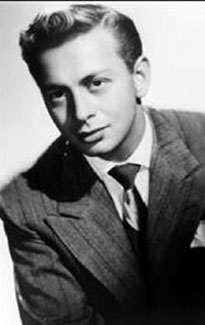

 By right of the film, "Blue Room" was transiently a standard for jazz vocalists for a few years, but it really wasn't that good. Even Mel can't trick us into finding it timeless today, but he has charisma & a sweet voice. Too bad this couldn't've been his great hit "Blue Moon" instead of "Blue Room" though.
By right of the film, "Blue Room" was transiently a standard for jazz vocalists for a few years, but it really wasn't that good. Even Mel can't trick us into finding it timeless today, but he has charisma & a sweet voice. Too bad this couldn't've been his great hit "Blue Moon" instead of "Blue Room" though.
 After we've seen the musicians, out strolls Mel to share the front of the staged setting, on the lower stage next to the harpist. He begins the hoary tune:
After we've seen the musicians, out strolls Mel to share the front of the staged setting, on the lower stage next to the harpist. He begins the hoary tune:

 This is the only one of the telescriptions that attempts to include acting as was done in the earlier soundies of the 1940s.
This is the only one of the telescriptions that attempts to include acting as was done in the earlier soundies of the 1940s.
 It sounds like the ideal theme song for a frightening film noir. The film could even have been titled Trouble is a Girl.
It sounds like the ideal theme song for a frightening film noir. The film could even have been titled Trouble is a Girl. 